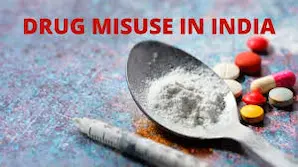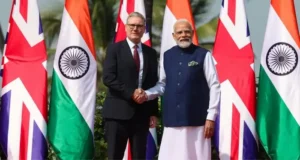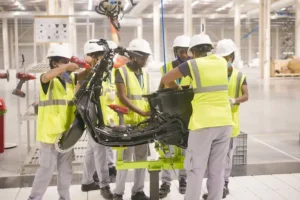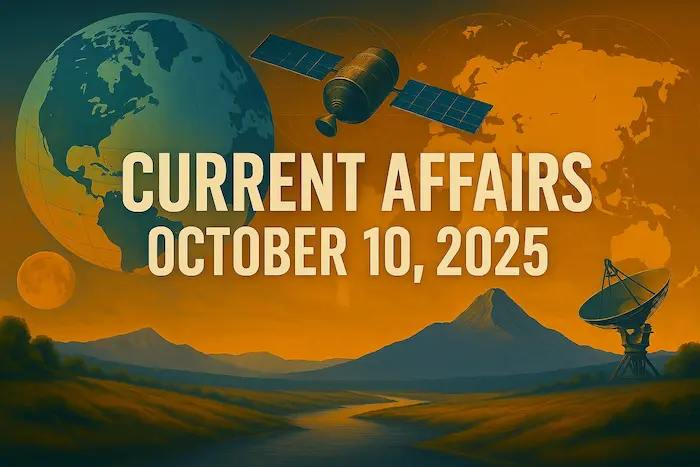1. PM-KUSUM Scheme – India to Promote it Globally – Governance

Why in News?
The Government of India plans to expand the reach of the PM-KUSUM (Pradhan Mantri Kisan Urja Suraksha evam Utthan Mahabhiyan) scheme to African and island nations through the International Solar Alliance (ISA) platform.
Background & Objective
Launched in 2019 by the Ministry of New and Renewable Energy (MNRE).
Aimed at improving energy and water security for farmers while promoting clean energy.
Seeks to add 34,800 MW of solar capacity by March 2026.
Aligned with India’s broader goals under the Paris Agreement and Net Zero 2070 targets.
Key Features of PM-KUSUM
Eligible Beneficiaries:
Individual Farmers
Groups of Farmers
Farmer Producer Organizations (FPOs)
Cooperatives
Water User Associations
Three Main Components of PM-KUSUM:
Component A:
Decentralized Solar Plants (10,000 MW) on barren or fallow land.
Capacity: 500 kW to 2 MW.
Power purchased by DISCOMs at tariff fixed by State Electricity Regulatory Commissions (SERCs).
Plants must be within a 5 km radius of substations.
Component B:
2 million standalone solar pumps for off-grid areas.
Farmers can replace diesel pumps with solar pumps up to 7.5 HP.
Supports clean irrigation and reduces dependence on fossil fuels.
Component C:
Solarisation of 1.5 million grid-connected pumps.
Enables farmers to use solar for irrigation and sell surplus power to DISCOMs.
Encourages income diversification and clean energy use.
Global Context: Expansion through ISA
India aims to promote PM-KUSUM as a model for sustainable rural energy solutions in Africa and Small Island Developing States (SIDS).
Supports India’s leadership in global climate diplomacy and South-South cooperation.
Benefits & Implications
Reduces farmer dependence on subsidized electricity/diesel.
Encourages private investment in solar infrastructure.
Supports decentralized renewable power generation.
Aligns with India’s National Solar Mission and SDG Goals (especially SDG 7: Affordable and Clean Energy).
Exam Connect – Possible Questions
Prelims
1. With reference to the PM-KUSUM Scheme, which of the following statements is/are correct?
1.It supports the installation of only grid-connected solar pumps.
2.It allows farmers to sell surplus electricity generated from solar energy.
3.It is implemented by the Ministry of Agriculture and Farmers Welfare.
Select the correct answer:
A. 1 and 2 only
B. 2 only
C. 1 and 3 only
D. 2 and 3 only
Answer: B . 2 only
2. The Component-A of PM-KUSUM Scheme focuses on:
A. Solarization of diesel-based pumps
B. Standalone solar pump installation in tribal regions
C. Decentralized solar power plants on barren land
D. Rooftop solar installation in urban homes
Answer: C. Decentralized solar power plants on barren land
Mains
1.”The PM-KUSUM scheme can be a game-changer for rural India by integrating clean energy with agricultural development.” Discuss the components, objectives, and the challenges faced in the implementation of the PM-KUSUM scheme.
2.Examine the significance of India’s initiative to promote the PM-KUSUM scheme in African and island nations through the International Solar Alliance. How does this align with India’s foreign policy and climate leadership goals?
2. Draft National Labour & Employment Policy – Shram Shakti Niti 2025 – Governance

Why in News?
The Ministry of Labour and Employment has released the draft of Shram Shakti Niti 2025 — the National Labour & Employment Policy — for public consultation, signaling a shift from regulation to facilitation in India’s labour governance model.
Objective
Aligns with India’s vision of a Viksit Bharat (Developed India) by 2047.
Aims to redefine the role of the Labour Ministry as an employment facilitator.
Focus on building a fair, inclusive, technology-driven labour ecosystem.
Key Highlights of the Draft Policy
Foundational Principles:
Dignity of Labour
Universal Inclusion
Worker Welfare
Data-Driven Governance
Social Dialogue & Participation
Strategic Priorities (7 Pillars):
Employment Generation
Universal Social Security
Occupational Safety and Health (OSH)
Formalisation of Informal Work
Skill Development and Upskilling
Women and Youth Empowerment
Labour Market Resilience through Technology
Key Digital & Structural Reforms
1. National Career Service (NCS):
To function as India’s Digital Public Infrastructure for Employment.
Features:
AI-enabled job matching
Skill mapping and credential verification
Career counseling and employment facilitation
2. Unified Labour Stack:
Integration of databases like:
EPFO (Employees’ Provident Fund Organisation)
ESIC (Employees’ State Insurance Corporation)
e-Shram (Unorganised worker database)
NCS
Purpose: Enable real-time labour market insights, policy coordination, and targeted welfare delivery.
3. Support to Labour Law Reforms:
Complements the consolidation of 29 central labour laws into four labour codes:
Code on Wages
Code on Social Security
Industrial Relations Code
Occupational Safety, Health and Working Conditions Code
Expected Outcomes
Universal worker registration, including for informal and gig workers.
Increased female labour force participation, especially in non-traditional sectors.
Strengthening of formal employment and reduction in precarious work.
Creation of a resilient and skilled workforce aligned with future-of-work demands.
Broader Significance
Reflects India’s transition to a knowledge and service-based economy.
Reinforces India’s position in the global labour policy discourse.
Lays the foundation for a “Worker-Centric, Future-Ready” India.
Exam Connect – Possible Questions
Prelims
1. Which of the following is/are features of the draft Shram Shakti Niti 2025?
1.Establishment of a Universal Basic Income scheme
2.Integration of EPFO, ESIC, e-Shram, and NCS databases
3.Use of AI for job matching and skill mapping
Select the correct answer:
A. 1 and 2 only
B. 2 and 3 only
C. 1 and 3 only
D. 1, 2 and 3
Answer: B. 2 and 3 only
2. The National Career Service (NCS) under the draft Labour Policy is best described as:
A. A minimum wage fixing platform
B. A government internship portal
C. A digital platform for job matching and employment services
D. A labour union regulatory framework
Answer: C. A digital platform for job matching and employment services
Mains
1.“India’s labour governance is shifting from regulation to facilitation.” Critically evaluate the key features and potential impact of the draft National Labour and Employment Policy (Shram Shakti Niti 2025).
2. Discuss how the Unified Labour Stack and National Career Service platform can help in improving formalisation of employment and labour market efficiency in India.
3. Combating Counterfeit Medicines: Integrating Law, Forensics & Enforcement – Governance

Why in News?
India, globally known as the “Pharmacy of the World”, is grappling with a surge in counterfeit and substandard medicines, raising serious public health and regulatory concerns. Recent fatalities linked to adulterated cough syrups have exposed severe gaps in drug regulation and enforcement mechanisms.
Background
India is the world’s largest provider of generic drugs, exporting to 200+ countries.
However, the increasing infiltration of fake medicines in both domestic and export supply chains has damaged public trust and international credibility.
The issue has been exacerbated by a low conviction rate (just 5.9%) in counterfeit drug cases.
Key Issues Identified
1. Outdated Legal Framework
The Drugs & Cosmetics Act, 1940 (D&C Act) lacks provisions to tackle transnational and organized pharmaceutical crimes.
It is inadequate to address modern counterfeit networks using digital and cross-border tools.
2. Supreme Court Verdict – Ashok Kumar (2020)
Restricted powers to register offenses under D&C Act to Drug Control Officers only.
Police cannot take suo motu action, creating an enforcement vacuum.
3. Legal Petition by IPA (Indian Pharmaceutical Alliance)
Filed a Public Interest Litigation (PIL) seeking:
Restoration of police powers in drug-related offenses.
Stronger inter-agency collaboration.
Proposed Multi-Dimensional Response
1. Forensic Science Integration
Use of chemical analysis, digital traceability, and evidence-based prosecution.
Enhances legal robustness and increases conviction chances.
2. Joint Enforcement Model
Combine:
Scientific expertise of Drug Control Officers
Investigative power of Police
Ensures quick response, better evidence collection, and deterrence.
3. Legal Reforms
Amend the D&C Act to:
Enable shared jurisdiction between police and regulators.
Recognize organized drug counterfeiting as a serious crime.
4. Use of Bharatiya Nyaya Sanhita (BNS), 2023
Recognizes organized crime, allowing formation of:
Special Investigation Teams (SITs)
Inter-agency task forces
5. Financial & Digital Investigations
Involve agencies like:
ED (Enforcement Directorate)
SFIO (Serious Fraud Investigation Office)
Track money trails, shell companies, and digital supply chains.
Outcomes Expected
Stronger regulatory enforcement
Higher conviction rates
Protection of public health
Restoration of India’s global pharma reputation
Exam Connect – Possible Questions
Prelims
1. Consider the following statements about the Drugs and Cosmetics Act, 1940:
1.It empowers both police and drug inspectors to initiate action against counterfeit medicines.
2. It has been recently amended to include cross-border pharmaceutical crimes.
Which of the above statements is/are correct?
A. 1 only
B. 2 only
C. Both 1 and 2
D. Neither 1 nor 2
Answer: D. Neither 1 nor 2
2. Which of the following tools/mechanisms are proposed to combat counterfeit drugs in India?
1.Special Investigation Teams (SITs)
2.Unified Labour Stack
3.Forensic chemical analysis
4.Financial tracking by enforcement agencies
Select the correct answer:
A. 1, 2 and 3 only
B. 1, 3 and 4 only
C. 2, 3 and 4 only
D. All of the above
Answer: B. 1, 3 and 4 only
Mains
1.“Counterfeit medicines pose a dual threat to public health and India’s global credibility as a pharma leader.” Discuss the legal and institutional gaps in India’s response and suggest a multi-pronged strategy to tackle this challenge.
2.Examine the role of forensic science and inter-agency coordination in strengthening India’s drug regulation enforcement. How can the integration of technology improve conviction rates in counterfeit drug cases?
4. India–U.K. Ties Anchored in a New Economic Partnership – International Relations

Why in News?
India and the United Kingdom have signed the Comprehensive Economic and Trade Agreement (CETA) in July 2025, during a high-level bilateral meeting in Mumbai between Indian Prime Minister Narendra Modi and UK Prime Minister Keir Starmer.
This agreement marks a strategic deepening of economic and political ties amid global economic uncertainty.
Objectives of the Partnership
Double bilateral trade by 2030
Promote tariff-free or reduced-tariff access to major export sectors
Strengthen technological, defense, and strategic cooperation
Establish people-centric frameworks for mobility and social security
Key Agreements & Features
1. Comprehensive Economic and Trade Agreement (CETA)
Aims to:
Boost trade in goods and services
Lower tariffs on Indian exports such as:
Textiles, pharmaceuticals, and agriculture
Reduce duties on UK exports like:
Scotch whisky, automobiles, and premium goods
Encourages investment and supply chain integration
2. Double Contributions Convention (DCC)
Removes the burden of dual social security contributions for Indian professionals working in the UK (for up to 3 years).
Enhances labour mobility and facilitates services trade.
3. Vision 2035 Roadmap
A long-term policy outline for cooperation in:
Defense & maritime security
Clean energy and climate action
Education and skills development
Health and pharmaceuticals
4. Technology Security Initiative (TSI)
Promotes collaboration in sensitive and emerging technologies:
Artificial Intelligence (AI)
Quantum computing
Cybersecurity frameworks
Geopolitical and Strategic Significance
Strengthens India–UK ties post-Brexit, when the UK is actively redefining its trade alignments.
Enhances India’s role in the Indo-Pacific as a strategic partner of Western democracies.
Builds on shared values of democracy, rule of law, and multilateralism.
Contributes to resilient supply chains and technological sovereignty in a polarized global order.
Expected Benefits
Bilateral trade expansion and job creation
Ease of doing business for professionals, students, and start-ups
Increased foreign direct investment (FDI) from the UK into India
Positioning India as a technology innovation partner in AI and quantum tech
Exam Connect – Possible Questions
Prelims
1. Which of the following sectors is most likely to benefit from tariff reductions under the India–UK CETA agreement?
A.Petroleum refining
B. Pharmaceuticals
C. Space exploration
D. Fisheries
Answer: B. Pharmaceuticals
(Pharmaceuticals, textiles, and agriculture are major Indian sectors to benefit.)
2. The Double Contributions Convention (DCC) recently signed between India and the UK relates to:
A. Joint contributions for climate finance
B. Dual taxation of business income
C. Social security obligations for professionals
D. Joint military spending for cyber defense
Answer: C. Social security obligations for professionals
Mains
1.“The India–UK Comprehensive Economic and Trade Agreement (CETA) represents more than a trade deal — it’s a geopolitical alignment.” Discuss the economic and strategic significance of the agreement in the current global context.
2. Examine the role of bilateral economic partnerships such as the India–UK CETA in advancing India’s interests in technology, trade, and human capital development.
5. Erosion of Workers’ Rights in India: Rising Industrial Accidents & Weakening Labour Protections – Economy

Why in News?
A series of fatal industrial accidents across India — including the Sigachi Industries chemical explosion, Gokulesh Fireworks blast, and the Ennore Thermal Power Station collapse — have reignited concerns about the weakening of workers’ rights and dilution of workplace safety norms, particularly under the new labour codes introduced in recent years.
Key Concerns
Rising Industrial Accidents
Fatal workplace incidents have become more frequent.
Most accidents are preventable, caused by:
Managerial negligence
Outdated machinery
Poor safety protocols
Lack of training and oversight
Policy Shifts Since 1990s
Gradual transition from protective labour policies to labour market flexibility.
Aimed at improving the ease of doing business, but often at the cost of worker welfare.
Historical Context
Evolution of Labour Laws in India
Factories Act, 1881: First legal recognition of factory workers’ rights.
Factories Act, 1948: Set the foundation for modern safety and welfare standards.
Subsequent laws provided for:
Working hours
Minimum wages
Occupational safety
Social security benefits
Current Trends
Weak enforcement of existing laws due to:
Low inspector-to-worker ratios
Corruption and lack of accountability
Increasing tendency to outsource responsibility through informal contracts
Recent Legal Changes
Occupational Safety, Health and Working Conditions (OSHWC) Code, 2020
Consolidates 13 existing labour laws.
Criticisms:
Shifts safety provisions from statutory guarantees to executive discretion
Thresholds for application exclude small enterprises (e.g., units with <10 workers)
Makes compliance self-regulated, weakening state inspections
Consequences of Weak Labour Protections
Human Cost: Loss of life, injuries, and long-term health effects.
Economic Impact: Reduced productivity, higher absenteeism, legal costs.
Reputation: Impacts India’s image as a responsible global manufacturing hub.
Informality: Most workers in the informal sector lack any legal protection.
Call for Action
Suggested Reforms
Restore statutory protections for worker safety and welfare.
Strengthen inspection mechanisms with transparency and digitization.
Ensure strict penalties for safety violations to create deterrence.
Reclassify labour protections as fundamental rights linked to the right to life and dignity (Article 21).
Promote worker representation and participation in workplace safety committees.
Broader Economic and Ethical Perspective
Sustainable economic growth cannot come at the cost of human life.
Safe workplaces are proven to:
Enhance worker efficiency
Improve employee retention
Build investor and consumer trust
Exam Connect – Possible Questions
Prelims
1. Which of the following statements correctly describes the Occupational Safety, Health and Working Conditions (OSHWC) Code, 2020?
A. It applies to all industrial units regardless of size
B. It removes statutory guarantees for workplace safety
C. It mandates on-site government inspections every quarter
D. It replaced the Industrial Disputes Act, 1947
Answer: B. It removes statutory guarantees for workplace safety
(The code provides more discretionary powers and lowers inspection obligations.)
2. Which of the following is not a direct consequence of poor workplace safety standards?
A. Increased labour productivity
B. Higher accident-related legal costs
C. Decreased investor confidence
D. Negative impact on economic sustainability
Answer: A. Increased labour productivity
Mains
1.“Labour reforms in India have increasingly focused on employer flexibility rather than worker protection.” Critically examine this trend in light of recent industrial accidents and the implementation of the OSHWC Code, 2020.
2. Discuss the challenges in enforcing workplace safety in India’s industrial sector. What policy and institutional changes are necessary to ensure that economic growth is not achieved at the cost of workers’ lives?

